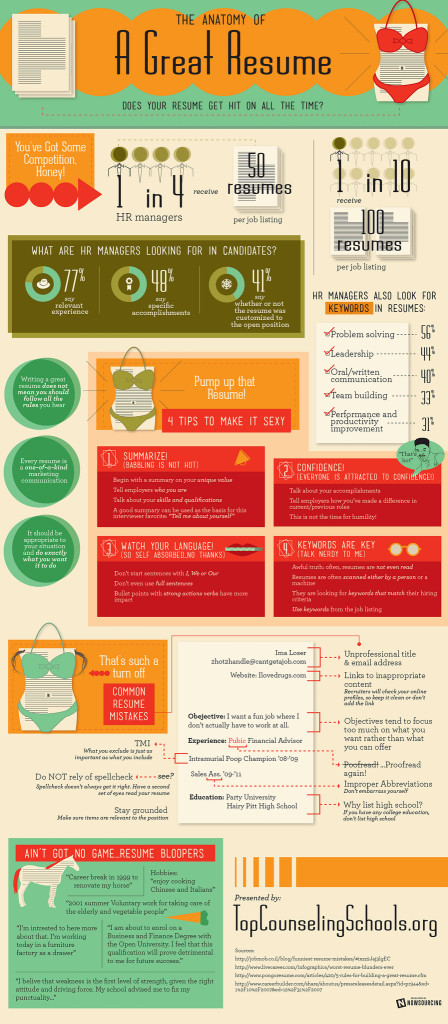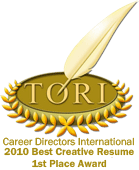 If you’re looking for ways to make your resume stand out from the crowd, beware. There are ways that make employers sit up and take notice, and there are ways that make them shake their heads and wonder what you were thinking.
If you’re looking for ways to make your resume stand out from the crowd, beware. There are ways that make employers sit up and take notice, and there are ways that make them shake their heads and wonder what you were thinking.
What not to do
Infographics: They’re popular on Pinterest and SlideShare, and done well, they can be very effective. The problem is, they’re usually not done well. Unfortunately, too few infographic resumes hit the mark when it comes to telling your story. They tend to be high on bling and low on content. See examples here. Furthermore, a 2014 study revealed 68% of hiring managers said they would look at an Infographic resume. That’s up significantly from 2013’s results, but it’s still not high enough for me. I would not rule out nearly a third of hiring managers just to have a cool-looking resume. So unless you are a graphic artist and want to show off your expertise, steer clear.
Video or PowerPoint: A video or PowerPoint / Prezi resume runs the same risk as an infographic resume. Let’s say your whole video resume is only 1 minute long. If the average time a hiring manager spends skimming a resume is 8 seconds, how long do you think this extremely busy person will spend with a video? If you’re a videographer, maybe. Otherwise, you’re risking being left out of the race.
Alternatively, there are things you can do with video and PowerPoint or other online presentations to enhance your branding. Just because using them for your resume isn’t a great idea doesn’t mean you can’t use them as an adjunct technique. Two ideas:
Page Size: Standing out means being noticed, and what better way than to send your resume on paper that is a different size from all the rest? Don’t do it. First of all, few resumes are sent hard copy anymore. Most companies want an electronic document. The ones that will accept a paper document won’t appreciate its not fitting in their folders and drawers. You’ll just annoy HR, and that’s rarely in your best interest.
What to do
So, let’s say you’re a Web designer and want to show off a bit of your expertise on your resume. The first rule is to consider your audience. Never go beyond the bounds of readability. Art for the sake of art belongs in a gallery, not on a resume. A resume is a marketing document with the purpose of promoting you to your next employer.
Graphic Elements: Tasteful graphic elements are appropriate for some resumes. The main thing to remember is that anything you add to the resume must add meaning, not decoration.
Color: Use color on your resume. Just don’t go nuts. I recommend enough color and format interest to be appealing and, more important, to lead the reader’s eye where you want it to go. Readability is the focus. If you’re just adding color for the sake of color, you’re probably making the document harder to read and defeating your purpose.
Font Size: Consistency is the road best followed here, too. You can certainly use a larger size type for your name and section headings, but the body type of the resume should be a consistent size, again, so the reader knows what to expect. Use font size changes judiciously and only when you want to signal a change in content. Lively
Writing: The best way to make your resume stand out is to write great content. Know what your target position requires, and match your resume to it. Use verbs, lots of verbs, to show action. Most of all, tell stories and use examples from your experience. Anyone can say they are a results-oriented team player who leads by example and has great communication skills. What results? What team? What did you lead? What did you communicate? Tell the story and win the interview.
Related
Job Search Fun: Ways to get inspired
Job Search Fun: Use engaging search strategies
Job Search Fun: Find partners to help with your job hunt
Image credit: Stefan Leijon








